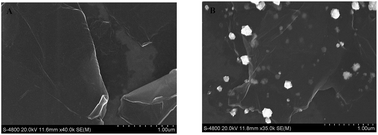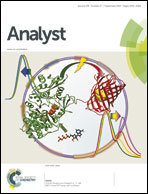Cleavage-based hybridization chain reaction for electrochemical detection of thrombin†
Abstract
In the present work, we constructed a new label-free “inter-sandwich” electrochemical aptasensor for thrombin (TB) detection by employing a cleavage-based hybridization chain reaction (HCR). The designed single-stranded DNA (defined as binding DNA), which contained the thrombin aptamer binding sequence, a DNAzyme cleavage site and a signal reporter sequence, was first immobilized on the electrode. In the absence of a target TB, the designed DNAzymes could combine with the thrombin aptamer binding sequence via complementary base pairing, and then Cu2+ could cleave the binding DNA. In the presence of a target TB, TB could combine with the thrombin aptamer binding sequence to predominantly form an aptamer–protein complex, which blocked the DNAzyme cleavage site and prevented the binding DNA from being cleaved by Cu2+-dependent DNAzyme. As a result, the signal reporter sequence could leave the electrode surface to trigger HCR with the help of two auxiliary DNA single-strands, A1 and A2. Then, the electron mediator hexaammineruthenium (III) chloride ([Ru(NH3)6]3+) was embedded into the double-stranded DNA (dsDNA) to produce a strong electrochemical signal for the quantitative measurement of TB. For further amplification of the electrochemical signal, graphene reduced by dopamine (PDA-rGO) was introduced as a platform in this work. With this strategy, the aptasensor displayed a wide linearity in the range of 0.0001 nM to 50 nM with a low detection limit of 0.05 pM. Moreover, the resulting aptasensor exhibited good specificity and acceptable reproducibility and stability. Because of these factors, the fabrication protocol proposed in this work may be extended to clinical application.


 Please wait while we load your content...
Please wait while we load your content...